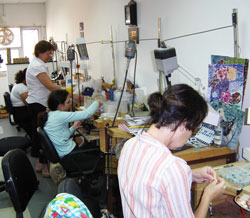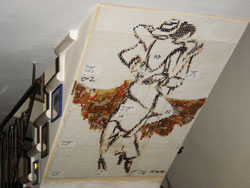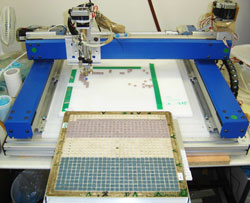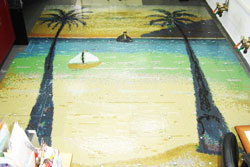Isel Cartesian Robots Automate Creation of Mosaics as Substantial Reduction in Cost

Time to Read: 4m 0s

Mosaic4u is located at the “Center for the Blind” in Herzelia, Israel. The center helps people with all sorts of handicaps. It provides a warm environment, education, consultation and work. Mosaic4u provides the center with production assignments that are part of their production process. This activity contributes to the center and to Mosaic4u – a real win-win situation with a touch of “doing right”. Haya (standing) is an arts teacher and is dedicated to promoting her students. The students make earrings, paintings and also mosaics.

The “Tango” mosaic installation was not an easy one as Mosaic4u did it on a negative slope (under a staircase). Eventually it was worth it.

This shows the Isel machine used by Mosaic4u Ltd.

This mosaic is undergoing a last check before being sent to the location.
The custom robot operates at a speed of 2.4 meters per second yet costs about $9,200. The new robot places 9000 3/8 tiles, enough to make a one square meter mosaic, in about 9 hours. Two Mosaic4u technicians got the Blueline robot working in this application in only one day. "Using a robot to assemble mosaics from the same glass tiles makes it possible for Mosaic4u to provide mosaics of equal quality as hand-made mosaics at a significantly lower price," said Boaz Glass, Chief Executive Officer of Mosaic4u.
Designing the mosaic
The process of creating a mosaic begins when the customer sends a photograph or painting to Mosaic4u. Glass says that for best results that original image should be at least 1.5 square meters (16 square feet). When the company receives the image from the customer, it uses special software to make several mosaic alternatives for the customer to choose from based on the same original image. The mosaic is not intended to be identical to the original image, but rather be inspired by it. Mosaic murals are an ancient art form and like any art should be judged for themselves. Mosaic4u’s technicians then make changes as needed to the images until the customer is completely satisfied.Traditionally, mosaics are manually assembled by hand by skilled craftsmen in an extremely time-consuming and costly process which puts them out of reach of all but the very affluent. Mosaic4u has revolutionized the mosaic industry by using robots to produce mosaics. Use of a robot to assemble the mosaic makes it possible to offer the product at a substantially lower cost than a hand-made mosaic while also increasing the accuracy of tile placement and reducing adtime. However, the company had a difficult time finding a robot that would fit the requirements of the application.
The robot requirements for this application are primarily speed, low costs and the ability to operate for millions of cycles. Most industrial robots are designed to lift heavier weights and maintain higher levels of accuracy than are required in this application. As a result, they are so expensive that they would be difficult to justify here. Mosaic4u first purchased an off-the-shelf robot but had difficulty making it work and when the company finally did get it running it turned out to be much too slow. The company made a comprehensive survey of industry robots but could not find one that met its needs.
Robots meet tough requirements
Then it discovered Isel’s Blueline series of belt-driven robots which are available in kits at a lower cost than off-the-shelf robots and can be configured to meet the needs of specific applications. Isel's Blueline robots can be configured up to 1550 x 2600 mm (61 x 102 inches) of travel with maximum speeds up to 2.4 meters per second. This gives the user a large format, high speed robot at a low price. A complete system for $9,200.00 includes a completely assembled 3 axis robot with travel of 1043 x 1043 x 143 mm, PCI motion controller that plugs into a PC, power electronics assembled in enclosure with power supply and Windows-based automation software.Each axis is contained in aluminum housing with a protective top cover. This allows the robots to stand up to industrial applications. Three axes of simultaneous motion can be provided to perform difficult multi-axis motions. chno's Cartesian robots provide smooth and continuous motion to avoid puddling when dispensing fluids or working with solder. The system can be mounted over very large parts or conveyor systems. This gives the unit great flexibility. An optional library of motion routines is available for software development for OEM applications.
Mosaic4u purchased a Blueline robot kit and two technicians got it working in this assembly application in just one day. The robot quickly demonstrated its ability to assemble 1000 tiles per hour or 16 tiles per minute, which exceeds the requirements of the application. Now, as soon as the customer approves the computerized mosaic design, Mosaic4u’s proprietary software divides the mosaic into 300 by 300 mm (12 by 12 inch) sheets and generates G-code programs for the Blueline robot to automatically assemble each sheet. The robot picks each tile with a vacuum gripper and glues it face-on to a transparent carrier sheet. Each mosaic sheet is labeled with the mosaic sheet’s xy coordinates.
Assembling the mosaic
A typical four square meter mosaic weighs about 25 kg and fits into a box measuring 320 by 320 by 300 millimeters. Assembly of the mosaic murals is simple and requires the same skills required to install any mosaic wall covering.The company does not design its mosaics in straight rows and columns unless requested by the customer. This means that the edges of the sheets are not straight lines but rather consist of a step-like pattern. This feature helps eliminate visible stitch marks between the sheets. The sheets combine in such a way that the film edges are almost touching each other and the tiles flow naturally from one sheet to the next.
Mosaic4u recommends that after placing each sheet the customer should fasten it to neighboring sheets with the supplied transparent adhesive strips that are supplied with its mosaics. The customer glues each sheet to all of the adjoining sheets using one stripe for each stitch. After the glue has bonded completely, the transparent sheets can be removed. The back side of each carrier board is then glued to the wall. Grout can be applied between the mosaic tiles if desired.
"When you look at a mosaic mural from a longer distance (2 meters away for 1 square meter mosaics or 6 meters away for 4 square meter mosaics) a new perspective kicks in," Glass said. "Light projection at an appropriate angle on the mosaic creates a fascinating effect of light and color. From a longer distance you will notice details that are not apparent at a close distance. Our unique design software provides three-dimensional effects that make certain image features "jump out of the wall."
Mosaic4u uses high quality glass tiles of the type that last for decades in pools, wall coverings and other applications. The tiles are water resistant, will not wear and will not fade even under direct sunlight. Across the globe there are many mosaics that have survived for centuries and even millenniums. If the customer does not like their mosaic mural, they can return it in its original package within 30 days and Mosaic4 u will refund the entire payment.
"Tedious to make and long lasting, sometimes image related but never realistic – mosaics are found in many of the world’s monuments, historical sites and contemporary buildings," Glass concluded. "A large mosaic mural provides a unique splendor, luxury and grace unlike any other type of decoration. The main difference between our mosaic murals and a hand-made mosaic is that robotic assembly makes it possible to sell our murals for considerably less. This makes it possible for nearly everyone to enjoy the beauty of one of the oldest known art forms. The Blueline robot has been instrumental in our ability to make mosaics available at lower cost than ever before. It has already delivered twelve months of flawless operation at a remarkably low price."
For more information contact: Isel USA Inc Linear Motion Systems, 69 Bloomingdale Rd. Phone: 516-595-7495 Fax: 516-595-7498 E-mail: Isel-Automation-Support.


